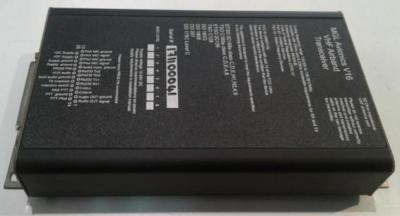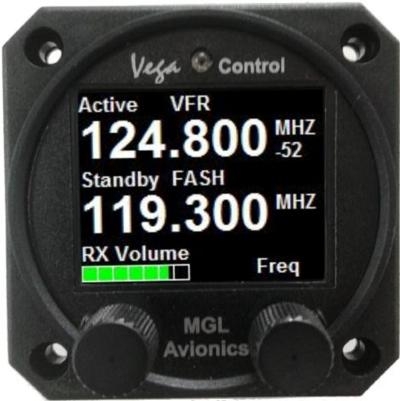Wed, Mar 28, 2018
Latest In A Family Of RF Products
The MGL Avionics V16 Com Radio and Razor/Vega Control Heads are now available in the US.

The V16 Com Radio is the latest generation and a new family of RF products by MGL Avionics and Chief Engineer Rainier Lamers. The V16 is the first in a new ecosystem of Com Radios, Nav Radios and controllers.
The V16 is a split design remote-mount Com Radio that is controlled via a separate controller/EFIS. The unit can be controlled by a mix (and any number) of Razor or Vega Control Heads. This means dual left seat and right seat radio displays and controls, or front and back (for tandem seat aircraft). It can also be controlled directly by an MGL Avionics iEFIS, with or without Razor/Vega Controls.
The V16 Com Radio boasts 10 Watts of Transmit Power (unmodulated carrier). When paired with a Razor/Vega control, the control can be connected to any EFIS or display that communicates with SL30/SL40 protocols, to tune the radio and load frequency lists.

The V16 includes a 2-place intercom with a wide-range VOX system. Multiple headsets can be connected to the Passenger channel if necessary. The advanced voice-activated intercom provides clear audio in noisy cockpits. In extreme cases the intercom can be activated via a switch connected to V16 (intercom PTT). The V16 can replay up to a minute of the last several transmissions. Miss a clearance from ATC? No problem - simply hit the Playback button on your Razor Control head or use a switch connected to discrete input in V16 Com to replay the last transmission. Hit the button again to play the previous transmission.

A full Interface Control Document (ICD) is published to allow for third party use of the V16 Com radio. Ideal for drone / UAV applications or for integrating with full glass panel systems where a remote VHF Com is required.
Other features include:
- Auxiliary Audio/Music input with auto-mute
- TX Interlock for dual radio installations
- Built-in SWR Meter to check antenna matching. Good antenna match will result in VSWR of 1.3 or less (ideal would be 1.0, which would mean no reflected power.
- Remote flip-flop
- Scan (monitor standby frequency).Channel Spacing: 25KHz or 8.33KHz
- Input Voltage: 12/14V and 24/28V (10-28 Volts)
- Current Draw at 13.8V Supply: RX: 0.3A and TX: 2.5A (10 Watts)
- Weight: 10.6 oz (300 grams)
(Images provided with MGL Avionics media release)
More News
Minimum Sector Altitude The lowest altitude which may be used under emergency conditions which will provide a minimum clearance of 300 m (1,000 feet) above all obstacles located in>[...]
Aero Linx: African Civil Aviation Commission (AFCAC) At AFCAC, our Safety Strategic Objective is to enhance Aviation Safety and the efficiency of Air Navigation Services in Africa.>[...]
The Local Controller’s Poor Judgment In Prioritization Of Their Ground Traffic Ahead Of Their Airborne Traffic Analysis: Hawaiian Airlines flight 70 (HAL70), N2165HA, an Airb>[...]
Get The Latest in Aviation News NOW on Instagram Are you on Instagram yet? It's been around for a few years, quietly picking up traction mostly thanks to everybody's new obsession >[...]
Also: Beech M-346N, Metro Gains H160 EMS STC, New Bell Boss, Affordable Flying Expo Tickets NOW On Sale! Purdue University’s Research Foundation and the Archaeological Legacy>[...]
 ANN's Daily Aero-Term (10.31.25): Minimum Sector Altitude [ICAO]
ANN's Daily Aero-Term (10.31.25): Minimum Sector Altitude [ICAO] ANN's Daily Aero-Linx (10.31.25)
ANN's Daily Aero-Linx (10.31.25) NTSB Final Report: Airbus A321-271N (A1); Cessna 172N (A2)
NTSB Final Report: Airbus A321-271N (A1); Cessna 172N (A2) ANN FAQ: Follow Us On Instagram!
ANN FAQ: Follow Us On Instagram! Airborne 10.30.25: Earhart Search, SpaceX Speed Limit, Welcome Back, Xyla!
Airborne 10.30.25: Earhart Search, SpaceX Speed Limit, Welcome Back, Xyla!





